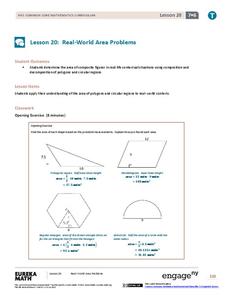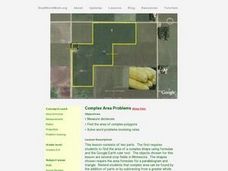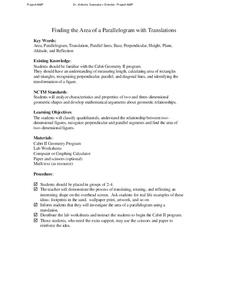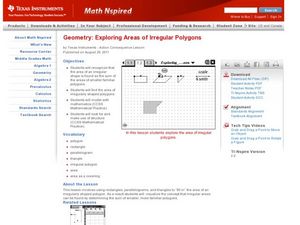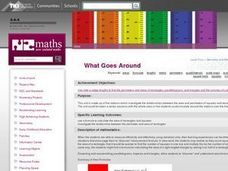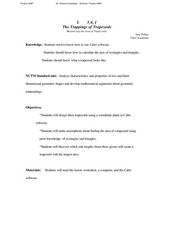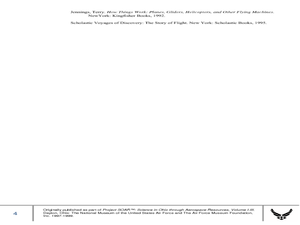EngageNY
Real-World Area Problems
Not all structures take the shape of a polygon. The 21st lesson in a series of 29 shows young mathematicians they can create polygons out of composite shapes. Once they deconstruct the structures, they find the area of the composite figure.
EngageNY
Perimeter and Area of Polygonal Regions Defined by Systems of Inequalities
When algebra and geometry get together, good things happen! Given a system of inequalities that create a quadrilateral, learners graph and find vertices. They then use the vertices and Green's Theorem to find the area and perimeter of...
Curated OER
Investigating Area Relationships
Learners investigate the area of various figures. They construct triangles and quadrilaterals using Cabri Jr. and discuss the relationships between different angles, side lengths, and figures.
Curated OER
Areas of Trapezoids, Rhombuses and Kites
Students calculate the area of different polygons. In this geometry lesson, students find the area for trapezoids, rhombuses and kites.
Curated OER
Complex Area Problems
Students calculate the area of different polygons. In this geometry instructional activity, students find the area of complex polygons. They solve word problems using rates and distances.
Balanced Assessment
Walkway
Evaluate different aspects of geometry with one task. An assessment activity prompts learners to determine the area of a pathway in the shape of a parallelogram. The Pythagorean Theorem and area formulas for various polygons provide the...
Curated OER
Finding the Area of a Parallelogram with Translations
Students calculate the area of parallelograms. In this geometry lesson, students identify properties of parallelograms and use to to solve problems. They create polygons using Cabri software.
Curated OER
Finding the Area of a Parallelogram with Translations
Pupils calculate the area of a parallelogram. In this geometry lesson, students perform translation using a coordinate plane and coordinate pairs. They perform translation on other polygons.
Curated OER
Area-Time to Get in Shape
Young scholars investigate the properties of triangles and parallelograms. For this geometry lesson, students calculate the formula used to find the are of a triangle and other polygons. They create a visual model to represent their...
Curated OER
Exploring Areas of Irregular Polygons
Young scholars solve for the area of different polygons. In this geometry lesson, students identify and differentiate between regular and irregular polygons. They use properties of irregular polygons to solve problems.
Curated OER
Area Unit
Students solve the area for parallelograms,squares, rectangles, trapezoids, and triangles. In this geometry lesson, students compare and contrast two dimensional shapes and apply their properties to solving real life scenarios. This is a...
Mathematics Vision Project
Module 5: Modeling with Geometry
Solids come in many shapes and sizes. Using geometry, scholars create two-dimensional cross-sections of various three-dimensional objects. They develop the lesson further by finding the volume of solids. The module then shifts...
Curated OER
Investigating Area Using Tangrams
Tenth graders connect the history of geometry to problem solving. In this geometry lesson, 10th graders investigate polygons through hands on manipulatives and solve problems relating to parallelograms and triangles. They calculate the...
Curated OER
Similarity and Dilations - Discover Properties of Similar Figures
Learners investigate properties of similar figures. For this properties of similar figures lesson, pupils construct similar figures using Cabri Jr. They dilate their figure to create a similar one, and discuss the relationships between...
Curated OER
Tricky Traps
Students create identify properties of trapezoids. In this geometry lesson plan, students calculate the area of given trapezoids and review the area formula for parallelograms. They draw a correlation between the area of a trapezoid and...
Curated OER
What Goes Around
Fourth graders investigate the relationships between the area and perimeters of squares and rectangles. They calculate the perimeter of rectangles and squares using a formula. Students investigate the relationship between the perimeter...
Curated OER
Quadrilateral Attributes
Young scholars classify quadrilaterals. In this quadrilateral lesson, students identify the characteristics of quadrilaterals. They write their findings in a journal. Young scholars use geoboards to create quadrilaterals from given...
Curated OER
Ara of Circles
Students identify the differentiate the different properties of circles and parallelograms. In this geometry lesson, students calculate the area of each solid and identify the formula. They relate Pi to the circumference of a circle.
Curated OER
The Trappings of Trapezoids
Students define trapezoids and their shapes. In this geometry lesson plan, students calculate the area of a trapezoid and a parallelogram. They use Cabri software to make investigations.
Curated OER
Area of Composite Figure.
Tenth graders predict the shape of a geometric figure in 3D. In this geometry lesson, 10th graders construct 3D shapes to perfect their knowledge of measuring and predicting. This assignment is also available as an online interactive...
Curated OER
Tangram Puzzles
Students explore the origin of tangram. In this algebra lesson, students form different shapes and figures using tangram. They solve for the area of different shapes without using any geometric formulas, but the idea of tangram being put...
Curated OER
Volume of Prisms
Students calculate the volume of different polygons. In this geometry lesson plan, students identify the relationship between base and height. They calculate the area of each prism and cylinder.
Curated OER
Parachutes: Is it Surface Area or Shape?
Students investigate how to make a good parachute. In this physics lesson, students observe the motion of parachutes as it falls and measure the time. They collect data and calculate the average descent time for each canopy shape.
Curated OER
Measurement Investigations 1
Fifth graders find perimeters, areas, and volumes of everyday objects and state the precision. They work in small groups in order to take measurements, perform calculations, and write a group report about the investigation.
